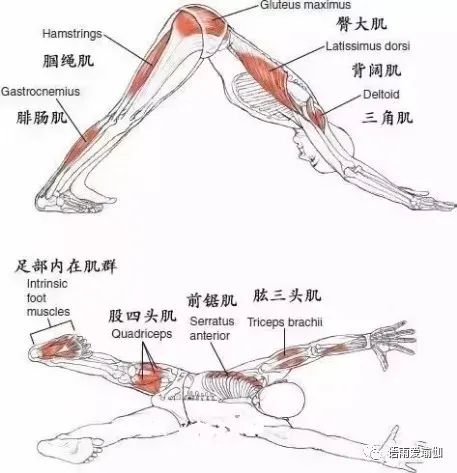In yoga, there are always some specific postures
. 
Do it at least once in a specific Yoga sequence
.
Down dog and board are two of them! Let’s see how to practice them safely and align them correctly
.
We all know these positions are good
.
But the question is: have you ever checked your down dog? And your plate? How to find the perfect alignment in the down dog pose: enter the table pose with shoulders above the wrists and hips above the knees
.
Measure the distance between hands and feet
.
Press your toes down and straighten your arms and legs
.
Push your hips back
.
Practice steps: prepare for the four corner kneeling position, open both hands and feet with the same width as the shoulders, put both hands directly under the shoulders and knees directly below the hips > exhale, step on the heels of both feet, push the hip backward and upward, push the sciatic bone to the highest point, and the body is in an inverted “V” shape > step on the heels with force, straighten the knees, tighten the thigh muscles, and keep the heels and knees straight to the hip and sciatic bone Push the ground with both hands with the base of the index finger and middle finger
.
Keep the arm, trunk and ischium in a straight line
.
Rotate the arm outward from the armpit to relax the shoulders and neck
.
Keep the head and spine in a straight line
.
Tips: keep your arms and legs straight so that your body looks like an inverted V shape
.
Extend your fingers so that your middle finger points to the front of the mat
.
Keep your ears level with your biceps, so that your neck is the extension of your spine
.
Adduct your abdomen and step your heels down on the mat
.
Benefits: strengthen your arms, legs and trunk, extend your palms, chest, and legs Back, hamstring tendons, legs and feet exercise back muscles, strengthen back strength, correct hunchback and other bad posture anatomical points: knee extension, hip flexion, spine neutral extension, shoulder flexion, elbow extension
.
How to find the perfect alignment in plate: move your weight forward from down dog until your shoulders are above your wrists (keep your arms straight)
.
When you can move back and forth between plank and down dog without having to move your arms or legs, you get the right alignment
.
Remember: don’t let your hips droop because it puts pressure on your lower back
.
Practice steps: prone, forehead point to the ground, feet together, hands on both sides of the chest, five fingers open, fingertips pointing to the front > toe hook back, heel pedal back, thigh muscles tighten > hands support, body up, slowly straighten the arm, into the board skill: > arms and legs are straight > spine and trunk in a straight line, like a board > the body is straight > the body is straight > the spine and trunk in a straight line Start your core by adduction of the abdomen > keep your hips level with your legs and spine > gently adduct your chin, and your neck is the continuation of your spine
.
Benefits: it can relieve mental pressure, strengthen the immune system, eliminate excess fat in hips, wrists, waist, abdomen, thighs and other parts, and make your body beautiful and smooth
.
At the same time, in plate exercise, it can improve the stability of shoulder belt, pelvic belt and trunk, strengthen abdominal muscles, strengthen muscle endurance and muscle control
.
Anatomical points: scapula abduction, hip neutral extension and adduction, knee extension, spine neutral extension
.
Correct alignment is the key to safe and effective practice
.
Enjoy the benefits of these classic postures!.
.

